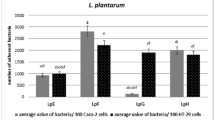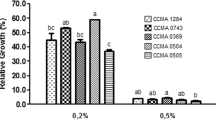Abstract
Objectives
The objective of this study was to evaluate the ability of Lactobacillus curvatus CRL705, CRL1532, and CRL1533 and Lactobacillus sakei CRL1613 to survive under simulated gastrointestinal conditions. Moreover, a microencapsulation approach was proposed to improve gastrointestinal survival. Finally, experiments were performed to demonstrate that Lactobacillus spp. can modulate the ability of Listeria monocytogenes FBUNT to adhere to and invade Caco-2 cells.
Results
Lactobacillus strains were encapsulated in alginate beads to enhance the survival of bacteria under in vitro gastrointestinal conditions. All strains hydrolyzed bile salts using chenodeoxycholic acid as a substrate and adhered to Caco-2 cells. Cell-free supernatants (CFSs) showed antimicrobial activity against L. monocytogenes as demonstrated by agar diffusion assays. The average percentages of L. monocytogenes adhesion decreased from 67.74 to 41.75 and 38.7% in the presence of 50 and 90% (v/v), respectively, for all CFSs tested. The highest concentrations of CFSs completely inhibited the L. monocytogenes invasion of Caco-2 cells.
Conclusions
The studied Lactobacillus strains have protective effects against the adhesion and invasion of L. monocytogenes FBUNT. Alginate encapsulation of these bacteria improved gastrointestinal tolerance such that they could be further studied as potential probiotics against intestinal pathogenic bacteria.




Similar content being viewed by others
References
Aazami N, Jouzani GS, Khodaei Z, Meimandipour A, Safari M, Goudarzvand M (2014) Characterization of some potentially probiotic Lactobacillus strains isolated from Iranian native chickens. J Gen Appl Microbiol 60:215–221
Abeijón Mukdsi MC, Argañaraz Martínez E, Perez Chaia A, Medina RB (2016) Feruloyl esterase activity is influenced by bile, probiotic intestinal adhesion and milk fat. Benef Microbes 7:597–607
Castellano P, Farías ME, Holzapfel W, Vignolo G (2001) Sensitivity variations of Listeria strains to the bacteriocins lactocin 705, enterocin CRL35 and nisin. Biotechnol Lett 23:605–608
Castellano P, Raya R, Vignolo G (2003) Mode of action of lactocin 705, a two component bacteriocin from Lactobacillus casei CRL705. Int J Food Microbiol 85:35–43
Chandramouli V, Kailasapathy K, Peiris P, Jones M (2004) An improved method of microencapsulation and its evaluation to protect Lactobacillus spp. in simulated gastric conditions. J Microbiol Methods 56:27–35
Corbo MR, Bevilacqua A, Speranza B, Di Maggio B, Gallo M, Sinigaglia M (2016) Use of alginate beads as carriers for lactic acid bacteria in a structured system and preliminary validation in a meat product. Meat Sci 111:198–203
De Prisco A, Maresca D, Ongeng D, Mauriello G (2015) Microencapsulation by vibrating technology of the probiotic strain Lactobacillus reuteri DSM 17938 to enhance its survival in foods and in gastrointestinal environment. LWT Food Sci Technol 61:452–462
Fontana C, Vignolo G, Cocconcelli P (2005) PCR-DGGE analysis for the identification of microbial populations from Argentinean dry fermented sausages. J Microbiol Methods 63:254–263
Fontana C, Cocconcelli P, Vignolo G, Saavedra L (2015) Occurrence of antilisterial structural bacteriocins genes in meat borne lactic acid bacteria. Food Control 47:53–59
Food and Agriculture Organization of the United Nations/World Health Organization (FAO/WHO) (2001) Health and nutritional properties of probiotics in food including powder milk with live lactic acid bacteria. Report of a Joint FAO/WHO working group in Córdoba, Argentina. http://www.who.int/foodsafety/publications/fs_management/probiotics/en/index.htm
Food and Agriculture Organization of the United Nations/World Health Organization (FAO/WHO) (2002) Guidelines for the evaluation of probiotics in food. Report of a Joint FAO/WHO working group in London Ontario, Canada. http://www.who.int/foodsafety/publications/fs_management/probiotics2/en/index.html
Franz CM, Specht P, Haberer P, Holzapfel W (2001) Bile salt hydrolase activity of enterococci isolated from food: screening and quantitative determination. J Food Prot 64:725–729
Ghequire MGK, De Mot R (2018) Turning over a new leaf: bacteriocins going green. Trends Microbiol 26:1–2
Gomes BC, Rodrigues MR, Winkelströter LK, Nomizo A, de Martinis ECP (2012) In vitro evaluation of the probiotic potential of bacteriocin producer Lactobacillus sakei 1. J Food Prot 75:1083–1089
Hebert EM, Saavedra L, Taranto MP, Mozzi F, Magni C, Nader ME, Font de Valdez G, Sesma F, Vignolo G, Raya RR (2012) Genome sequence of the bacteriocin-producing Lactobacillus curvatus strain CRL705. J Bacteriol 194:538–539
Hill C, Guarner F, Reid G, Gibson GR, Merenstein DJ, Pot B, Morelli L, Canani RB, Flint HJ, Salminen S, Calder PC, Sanders ME (2014) Expert consensus document. The International Scientific Association for Probiotics and Prebiotics consensus statement on the scope and appropriate use of the term probiotic. Nat Rev Gastroenterol Hepatol. 11:506–514
Mayr-Harting A, Hedges AJ, Berkeley RCW (1972) Methods for studying bacteriocins. In: Norris JR, Ribbons DW (eds) Methods in microbiology. Academic Press, New York, pp 313–342
Montville TJ, Bruno ME (1994) Evidence that dissipation of proton motive force is a common mechanism of action for bacteriocins and other antimicrobial proteins. Int J Food Microbiol 24:53–74
Moroni O, Kheadr E, Boutin Y, Lacroix C, Isma F (2006) Inactivation of adhesion and invasion of food born Listeria monocytogenes by bacteriocin-producing Bifidobacterium strains of human origin. Appl Environ Microbiol 72:6894–6901
Ndahetuye JB, Koo OK, O’Bryan CA, Ricke SC, Crandall PG (2012) Role of lactic acid bacteria as a biosanitizer to prevent attachment of Listeria monocytogenes F6900 on deli slicer contact surfaces. J Food Prot 75:1429–1436
Pérez Ibarreche M, Castellano P, Vignolo G (2014) Evaluation of anti-Listeria meat borne Lactobacillus for biofilm formation on selected abiotic surfaces. Meat Sci 96:295–303
Radoshevich L, Cossart P (2018) Listeria monocytogenes: towards a complete picture of its physiology and pathogenesis. Nat Rev Microbiol 16:32–46
Ross GR, Gusils C, Gonzalez SN (2008) Microencapsulation of probiotic strains for swine feeding. Biol Pharm Bull 31:2121–2125
Shah A, Gani A, Ahmad M, Ashwar BA, Masoodi FA (2016) β-Glucan as an encapsulating agent: effect on probiotic survival in simulated gastrointestinal tract. Int J Biol Macromol 82:217–222
Acknowledgements
We are grateful to The Bilateral Cooperation Program CONICET-FAPESP (2013/50498-5) for financial support of this study. We also thank Lucas Oliveira Sousa and Vanessa Maciel de Souza from FCFRP-USP for their excellent technical assistance with the cell line assays.
Author information
Authors and Affiliations
Corresponding author
Rights and permissions
About this article
Cite this article
Castellano, P., Pérez Ibarreche, M., Longo Borges, L. et al. Lactobacillus spp. impair the ability of Listeria monocytogenes FBUNT to adhere to and invade Caco-2 cells. Biotechnol Lett 40, 1237–1244 (2018). https://doi.org/10.1007/s10529-018-2572-x
Received:
Accepted:
Published:
Issue Date:
DOI: https://doi.org/10.1007/s10529-018-2572-x




